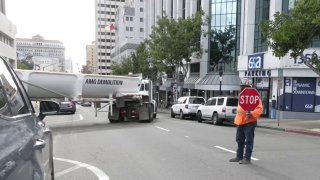
County officials originally said last week's sewage spill, which impacted at least 18 sites around the city of San Diego, involved a staggering 500,000 gallons of effluent.
Then, officials with the city of San Diego estimated the spill was 6% of what would have been processed that day at the primary municipal treatment plant in Point Loma, which, according to the city's website, sees 175 million gallons of sewage come and go in 24 hours.
On Monday, though, Tom Rosales, an assistant director with the water recovery branch of the city's public utilities department, said the spill was, in fact, estimated to be in the neighborhood of 11.2 million gallons of sewage.
Get San Diego local news, weather forecasts, sports and lifestyle stories to your inbox. Sign up for NBC San Diego newsletters.
The San Diego County shoreline was dotted with beach closures Tuesday due to several sewage spills in different citites. The coastal areas affected included San Diego Bay, "including all water north and west of Chollas Creek, up to Shelter Island;" South Ponto State Beach in Carlsbad; the nearby outlet of the Batiquitos Lagoon; and Park Morrison Pond in Sweetwater Regional Park, according to the San Diego County Department of Environmental Health and Quality.
Rosales said on Monday that most of the 11.2 million gallons of wastewater spilled within the confines of the city of San Diego would have gone into San Diego Bay via storm drains.
A power outage caused the city of San Diego pump station to stop working, a spokesperson for county DEHQ said. As a result of the malfunction, Pump Station 2 shut down, wastewater backed up and "there were spills in various locations in the Midway and downtown areas that flow into San Diego Bay," said Arian Collins, a public information officer for the city of San Diego.
Local
On Monday, Rosales said the city has still not determined what caused the spill.
"… it's a combination of just an off-chance failure with the sensor and the logic of the program, logic that operates the pumping system," Rosales said, adding, "we haven't completed our forensics evaluation yet. That's still being done and expect at some point to get an actual report from our staff to explain in more detail exactly why it failed."
And how much is this gonna cost taxpayers?
"They have a kind of a starting point, if you will, but then they have mitigating factors along the way where they consider your record and your response and so forth, and, ultimately, it is a negotiated process that will bring it down to, I'd say, kind of very high level to something more manageable," Rosales said, regarding penalties from the state, adding "again, that's a long process. So I don't want to guess what that might be, but we've been through it a couple of times, and we'll go through it again with them."
As far as cleanup costs go, Rosales said that homeowners and businesses have the option, if they are insured, to take care of the cleanup that way, or the city will provide cleanup via a firm it works with for mitigation. Until claims are made, a cost estimate for clean-up can't yet be provided
Rosales does not expect a repeat of the massive spill anytime soon.
"We don't ever want to spill," Rosales said. "It happened because of some equipment failure, and we don't expect it will happen again."
For updates on beach advisory and closure information, go here or call the 24-hour hotline at 619-338-2073.



